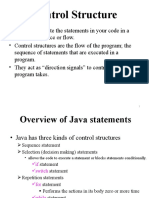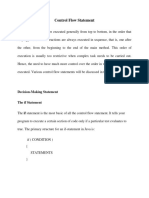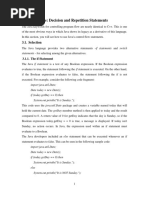0 ratings0% found this document useful (0 votes)
699 viewsSequence Structure in Java
Java uses sequence, selection, and repetition structures to control program flow. The sequence structure executes statements in the order written unless otherwise specified. Selection statements include if, if/else, and switch statements to select or skip actions based on conditions. Repetition statements like while, do/while, and for loops repeatedly execute actions as long as a condition remains true. These control structures use keywords like if, else, switch, while, do and for that cannot be reassigned as identifiers.
Uploaded by
Swapnil ChaudhariCopyright
© © All Rights Reserved
Available Formats
Download as DOCX, PDF, TXT or read online on Scribd
0 ratings0% found this document useful (0 votes)
699 viewsSequence Structure in Java
Java uses sequence, selection, and repetition structures to control program flow. The sequence structure executes statements in the order written unless otherwise specified. Selection statements include if, if/else, and switch statements to select or skip actions based on conditions. Repetition statements like while, do/while, and for loops repeatedly execute actions as long as a condition remains true. These control structures use keywords like if, else, switch, while, do and for that cannot be reassigned as identifiers.
Uploaded by
Swapnil ChaudhariCopyright
© © All Rights Reserved
Available Formats
Download as DOCX, PDF, TXT or read online on Scribd
You are on page 1/ 1
Sequence Structure in Java
The sequence structure is built into Java. Unless directed otherwise, the computer executes Java
statements one after the other in the order in which they are written—that is, in sequence.
Selection Statements in Java
Java has three types of selection statements (discussed in this chapter and Chapter 5). The if
statement either performs (selects) an action, if a condition is true, or skips it, if the condition is
false. The if…else statement performs an action if a condition is true and performs a different
action if the condition is false. The switch statement (Chapter 5) performs one of many different
actions, depending on the value of an expression.
The if statement is a single-selection statement because it selects or ignores a single
action (or, as we will soon see, a single group of actions). The if…else statement is called a
double-selection statement because it selects between two different actions (or groups of
actions). The switch statement is called a multiple-selection statement because it selects among
many different actions (or groups of actions).
Repetition Statements in Java
Java provides three repetition statements (also called looping statements) that enable programs
to perform statements repeatedly as long as a condition (called the loop-continuation condition)
remains true. The repetition statements are the while, do…while and for statements. (Chapter 5
presents the do…while and for statements.) The while and for statements perform the action (or
group of actions) in their bodies zero or more time if the loop-continuation condition is initially
false, the action (or group of actions) will not execute. The do…while statement performs the
action (or group of actions) in its body one or more times.
The words if, else, switch, while, do and for are Java keywords . Recall that keywords are
used to implement various Java features, such as control statements. Keywords cannot be used as
identifiers, such as variable names.
You might also like
- Chapter 3: Java Control Statements: 1. Selection StatementNo ratings yetChapter 3: Java Control Statements: 1. Selection Statement14 pages
- Advanced Programming Exit Exam Tutorial With QuestionsNo ratings yetAdvanced Programming Exit Exam Tutorial With Questions42 pages
- Java Control Statements - Control Flow in JavaNo ratings yetJava Control Statements - Control Flow in Java16 pages
- Control Statements: Eric Roberts CS 106A April 13, 2012No ratings yetControl Statements: Eric Roberts CS 106A April 13, 201223 pages
- Control Flow and Decision Making Statement (Module 3) - 110945No ratings yetControl Flow and Decision Making Statement (Module 3) - 11094525 pages
- Control Statement in Procedural programmingNo ratings yetControl Statement in Procedural programming9 pages
- Unit 3 Control Statements (Tapashi) EditedNo ratings yetUnit 3 Control Statements (Tapashi) Edited9 pages
- G-8 ch-6 Decision Control Structure -JavaNo ratings yetG-8 ch-6 Decision Control Structure -Java4 pages
- Chapter Three: Decision and Repetition Statements: 3.1. SelectionNo ratings yetChapter Three: Decision and Repetition Statements: 3.1. Selection15 pages
- Types of Java Statements: If If-Else SwitchNo ratings yetTypes of Java Statements: If If-Else Switch28 pages
- BE EXPERT IN JAVA Part- 2: Learn Java programming and become expertFrom EverandBE EXPERT IN JAVA Part- 2: Learn Java programming and become expertNo ratings yet
- Attendance Administrative System: Project Presentation OnNo ratings yetAttendance Administrative System: Project Presentation On15 pages
- Abstract Data Type (ADT) : Refer From ISRD BookNo ratings yetAbstract Data Type (ADT) : Refer From ISRD Book1 page
- Restaurant Executive System: There Are Five Types of Users For System. 1. Customer ClassNo ratings yetRestaurant Executive System: There Are Five Types of Users For System. 1. Customer Class4 pages
- Balancing of Load For Distributed File Systems in Clouds Using Load RebalancingNo ratings yetBalancing of Load For Distributed File Systems in Clouds Using Load Rebalancing69 pages







































































